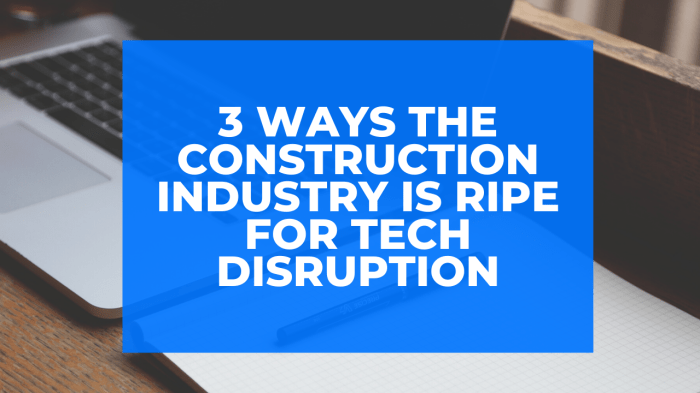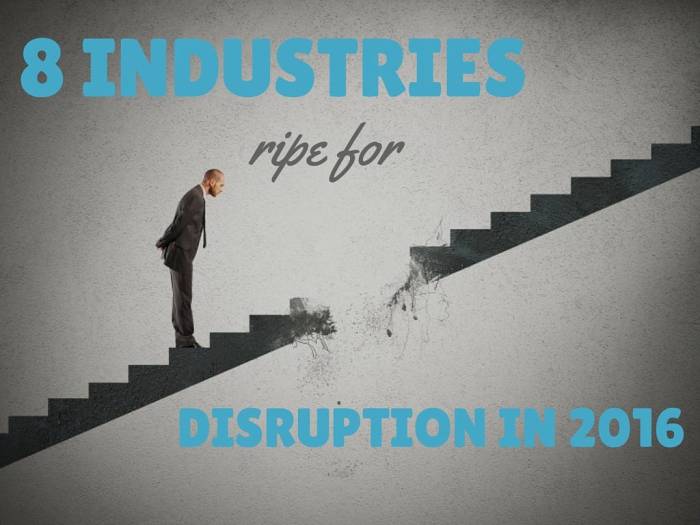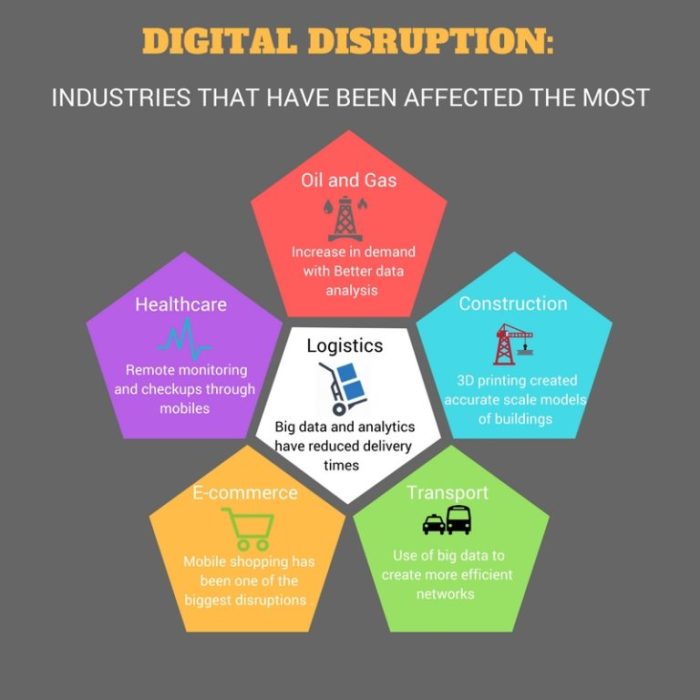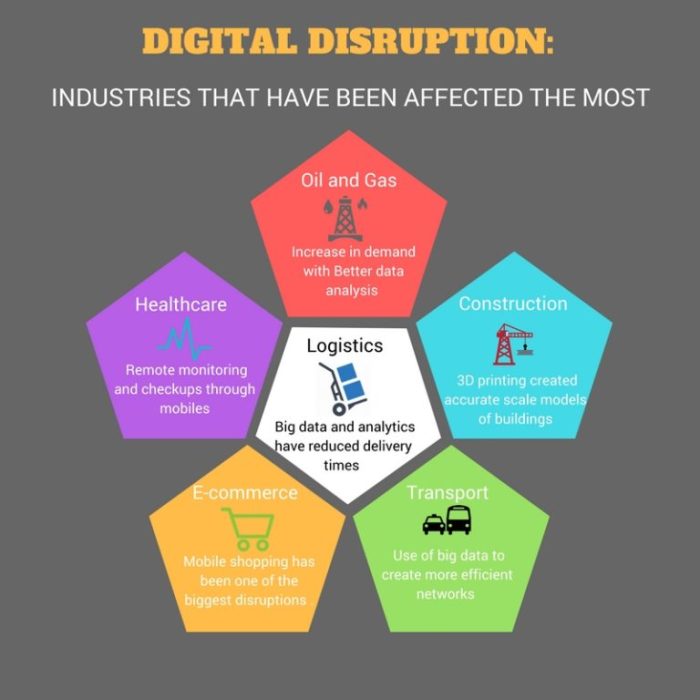These are the next 6 industries that are ripe for tech disruption, and it’s happening now. From healthcare to agriculture, the digital revolution is transforming the way we live, work, and interact with the world around us. The speed of innovation is breathtaking, and it’s pushing industries to adapt or be left behind.
The rise of artificial intelligence, blockchain technology, and other cutting-edge advancements are creating new possibilities and disrupting established norms. This is not just a technological shift, but a fundamental change in how we approach various sectors, leading to a more efficient, personalized, and interconnected future.
This blog delves into six industries poised for a tech-driven transformation, highlighting the exciting opportunities and challenges they face. We’ll explore how these disruptions are impacting everything from patient care and education to manufacturing, finance, and agriculture.
The Rise of Tech Disruption: These Are The Next 6 Industries That Are Ripe For Tech Disruption
The world is experiencing a wave of technological disruption that is transforming industries and reshaping the global economy. From ride-hailing services to online streaming platforms, technology is creating new business models, disrupting traditional industries, and driving innovation at an unprecedented pace.
Examples of Recent Tech Disruptions
The current wave of tech disruption is characterized by the emergence of new technologies and business models that are fundamentally changing how industries operate. Examples of recent successful tech disruptions include:
- Ride-hailing services:Uber and Lyft have disrupted the traditional taxi industry by offering a more convenient, affordable, and accessible transportation option. They leverage mobile technology and sophisticated algorithms to connect riders with drivers, optimizing routes and pricing in real-time.
- E-commerce:Amazon and Alibaba have revolutionized retail by creating online marketplaces that offer a vast selection of products and services, competitive prices, and convenient delivery options. These platforms leverage technology to optimize inventory management, logistics, and customer experience.
- Streaming services:Netflix and Spotify have disrupted the traditional entertainment industry by offering on-demand access to movies, TV shows, and music. These platforms leverage technology to personalize content recommendations, optimize streaming quality, and create immersive user experiences.
Key Factors Driving Tech Disruption
Several key factors are driving the current wave of tech disruption:
- Rapid technological advancements:The rapid pace of innovation in areas such as artificial intelligence (AI), cloud computing, and mobile technology is creating new possibilities for businesses and industries.
- Increased access to data:The availability of vast amounts of data, coupled with advanced analytics capabilities, allows businesses to gain deeper insights into customer behavior and market trends.
- Changing consumer expectations:Consumers are increasingly demanding personalized experiences, convenience, and affordability, driving businesses to adopt new technologies and adapt their business models.
- Falling costs of technology:The declining cost of technology, such as computing power and data storage, makes it easier for startups and small businesses to compete with established players.
Healthcare
The healthcare industry, traditionally slow to adapt, is now experiencing a wave of technological disruption. From AI-powered diagnostics to virtual consultations, technology is transforming the way patients receive care, making it more efficient, personalized, and accessible.
The Rise of AI in Healthcare
AI is revolutionizing healthcare by enhancing diagnostics and enabling personalized medicine. Machine learning algorithms can analyze vast amounts of medical data to identify patterns and predict disease risk, leading to earlier detection and more effective treatment. For example, AI-powered tools are being used to analyze mammograms for early breast cancer detection, and to predict patient outcomes after surgery.
Telehealth Platforms: Expanding Healthcare Access
Telehealth platforms, such as video conferencing and remote monitoring apps, are breaking down geographical barriers and making healthcare more accessible. Patients in rural areas or with limited mobility can now consult with specialists remotely, eliminating the need for expensive and time-consuming travel.
Do not overlook explore the latest data about forget about algorithms and models learn how to solve problems first.
For example, Teladoc and MDLive provide virtual consultations with doctors for a variety of conditions, while apps like Livongo manage chronic conditions like diabetes through remote monitoring and coaching.
Wearable Technology: Monitoring Health and Preventing Disease
Wearable devices like smartwatches and fitness trackers are empowering individuals to take control of their health. These devices continuously monitor vital signs, activity levels, and sleep patterns, providing valuable insights into individual health trends. This data can be used to identify potential health issues early on, allowing for preventative care and personalized interventions.
For example, Apple Watch’s ECG feature can detect irregular heart rhythms, potentially preventing heart attacks.
Education

Education, a cornerstone of societal progress, is ripe for tech disruption. Traditional models, often rigid and standardized, are being challenged by a wave of innovation that promises to personalize learning, enhance engagement, and democratize access to knowledge.
Personalized Learning Experiences Powered by AI
Imagine a future where education is tailored to the individual needs and learning styles of each student. This vision is rapidly becoming reality with the advent of AI-powered learning platforms. These platforms utilize sophisticated algorithms to analyze student data, such as learning patterns, strengths, and weaknesses, to create customized learning paths.
For instance, a student struggling with algebra might be presented with additional practice problems and interactive tutorials, while a student excelling in history might be challenged with advanced readings and research projects.
Innovative Educational Technologies
The educational landscape is teeming with innovative technologies that are revolutionizing the way students learn.
- Gamified Learning Platforms:Platforms like Kahoot! and Quizizz transform learning into an engaging game experience, fostering competition and collaboration while reinforcing key concepts.
- Virtual Reality (VR) and Augmented Reality (AR):VR and AR technologies offer immersive learning experiences, allowing students to explore historical sites, dissect virtual organs, or practice scientific experiments in a safe and interactive environment.
- Adaptive Learning Systems:Platforms like Khan Academy and Duolingo adjust the difficulty level of lessons based on student performance, providing personalized feedback and guidance.
Challenges and Opportunities in Online Education
The rise of online education presents both challenges and opportunities.
- Accessibility and Equity:Online education has the potential to bridge geographical and socioeconomic barriers, making quality education accessible to a wider population. However, disparities in access to technology and reliable internet connectivity can hinder inclusivity.
- Student Engagement and Motivation:Maintaining student engagement and motivation in online learning environments requires innovative pedagogical approaches and interactive tools.
- Teacher Training and Support:Effective integration of technology in education requires adequate training and support for educators, equipping them with the skills to leverage these tools effectively.
Manufacturing
The manufacturing industry is undergoing a dramatic transformation, fueled by the rise of automation and the adoption of Industry 4.0 technologies. This shift is reshaping production processes, enhancing efficiency, and creating new opportunities for innovation.
Robotics and Automation
The integration of robotics and automation is revolutionizing manufacturing by automating repetitive and complex tasks, leading to increased productivity and reduced errors. Robots are deployed across various stages of the manufacturing process, from assembly lines to quality control. For example, in automotive manufacturing, robots are used for welding, painting, and assembly, significantly speeding up production times and improving accuracy.
Impact of Industry 4.0 on Manufacturing, These are the next 6 industries that are ripe for tech disruption
Industry 4.0 refers to the digital transformation of manufacturing, driven by technologies such as the Internet of Things (IoT), artificial intelligence (AI), and cloud computing. This revolution is impacting manufacturing efficiency and cost reduction in various ways:
| Impact | Description |
|---|---|
| Increased Efficiency | Real-time data analysis and predictive maintenance enabled by IoT and AI optimize production processes, minimizing downtime and improving overall efficiency. |
| Reduced Costs | Automation reduces labor costs, while data-driven insights optimize resource allocation and minimize waste, leading to significant cost savings. |
| Enhanced Quality | Automated quality control systems ensure consistent product quality, minimizing defects and improving customer satisfaction. |
| Increased Flexibility | Industry 4.0 technologies enable manufacturers to adapt quickly to changing market demands and customize products based on specific customer needs. |
Benefits and Drawbacks of Advanced Manufacturing Technologies
Implementing advanced manufacturing technologies offers significant benefits, but also presents certain challenges:
Benefits
- Increased productivity and efficiency
- Reduced labor costs and improved quality
- Enhanced product customization and flexibility
- Improved safety and working conditions for employees
- Greater competitiveness in the global market
Drawbacks
- High initial investment costs for technology and infrastructure
- Potential job displacement as automation replaces human workers
- Need for skilled workers to operate and maintain advanced technologies
- Security concerns regarding data and system vulnerabilities
- Ethical considerations regarding the impact of automation on society
Finance

The financial industry, a cornerstone of modern economies, is undergoing a profound transformation fueled by technological innovation. Fintech, the convergence of finance and technology, is reshaping the way we manage our money, invest, and access financial services.
The Rise of Blockchain Technology
Blockchain technology, the underlying framework of cryptocurrencies like Bitcoin, is poised to revolutionize financial transactions. Its decentralized, transparent, and secure nature offers a compelling alternative to traditional systems.Blockchain offers several advantages for financial transactions:
- Enhanced Security: Transactions are encrypted and recorded on a distributed ledger, making them tamper-proof and highly secure.
- Increased Transparency: All transactions are publicly auditable, promoting accountability and trust within the financial system.
- Reduced Costs: By eliminating intermediaries, blockchain can streamline transactions, reducing fees and processing times.
- Faster Settlements: Blockchain transactions can be processed significantly faster than traditional methods, improving efficiency and liquidity.
Fintech Solutions for Financial Inclusion
Fintech solutions are playing a critical role in expanding financial inclusion, providing access to financial services for underserved populations.
- Mobile Banking: Mobile banking apps have democratized access to financial services, enabling individuals without traditional bank accounts to manage their money and make transactions. For example, M-Pesa in Kenya has revolutionized financial inclusion by providing mobile money services to millions of people.
- Microfinance Platforms: Online platforms connect borrowers with lenders, facilitating microloans for small businesses and individuals. This has empowered entrepreneurs and individuals in emerging markets to access capital and grow their businesses.
- Alternative Credit Scoring: Fintech companies are developing alternative credit scoring models that leverage non-traditional data sources, such as social media activity and online purchase history. This helps individuals with limited credit history gain access to loans and financial products.
Emerging Trends in Digital Banking and Personalized Financial Services
The digital banking landscape is evolving rapidly, driven by advancements in artificial intelligence (AI), machine learning, and data analytics.
- Personalized Financial Advice: AI-powered chatbots and robo-advisors provide personalized financial advice, tailoring investment strategies and financial planning recommendations based on individual needs and goals.
- Frictionless Transactions: Digital banking platforms offer seamless and secure transaction experiences, leveraging biometrics and other advanced technologies to enhance user authentication and security.
- Open Banking: Open banking initiatives allow customers to share their financial data with third-party apps and services, creating a more interconnected and personalized financial ecosystem.
Agriculture

The agricultural industry, responsible for feeding a global population exceeding 8 billion, is undergoing a technological revolution. Precision agriculture, data analytics, and innovative farming techniques are transforming traditional practices, leading to increased efficiency, sustainability, and food security.
Precision Agriculture: Optimizing Crop Yields and Resource Management
Precision agriculture leverages technology to optimize resource use and improve crop yields. It involves collecting data on various factors affecting crop growth, such as soil conditions, weather patterns, and plant health, using sensors, drones, and satellite imagery. This data is then analyzed to tailor farming practices to specific areas within a field, ensuring optimal resource allocation.
- Variable-rate fertilization: This technique applies different amounts of fertilizer to different parts of a field based on soil nutrient levels, reducing fertilizer waste and environmental impact.
- Precision irrigation: Using sensors and data analysis, farmers can optimize irrigation schedules, applying water only when and where it’s needed, minimizing water waste and maximizing water efficiency.
- Smart pest control: By monitoring crop health and identifying pests early, farmers can implement targeted pest control measures, reducing the use of harmful pesticides.
Data Analytics: Predicting Weather Patterns and Improving Farm Efficiency
Data analytics plays a crucial role in predicting weather patterns and optimizing farm operations. Weather data, collected from various sources, including weather stations and satellite imagery, is analyzed to provide farmers with accurate forecasts. This information allows them to make informed decisions about planting, harvesting, and irrigation, mitigating the risks associated with unpredictable weather conditions.
- Yield prediction: By analyzing historical weather data and current conditions, farmers can estimate potential crop yields, allowing them to make informed decisions about resource allocation and market strategies.
- Disease and pest forecasting: Data analysis can identify patterns in disease outbreaks and pest infestations, enabling farmers to take preventive measures and minimize crop losses.
- Optimizing farm management: Data analytics can help farmers track key metrics, such as crop yields, resource usage, and labor costs, identifying areas for improvement and optimizing overall farm efficiency.
Vertical Farming and Other Innovative Agricultural Technologies
Vertical farming, a method of growing crops in stacked layers, is gaining traction as a sustainable and efficient farming technique. By growing crops in controlled environments, vertical farms can maximize land use, reduce water consumption, and minimize pesticide use.
- Controlled environment agriculture (CEA): CEA involves growing crops in enclosed environments where factors like temperature, humidity, and light are precisely controlled, allowing for year-round production and increased yields.
- Hydroponics and aeroponics: These techniques grow plants without soil, using nutrient-rich water solutions or misting systems, respectively. This eliminates the need for traditional soil-based agriculture, reducing water consumption and land requirements.
- Robotics and automation: Robots and automated systems are being deployed in agriculture for tasks such as planting, harvesting, and weeding, increasing efficiency and reducing labor costs.





